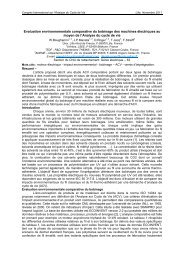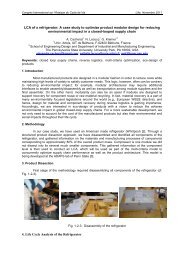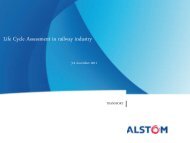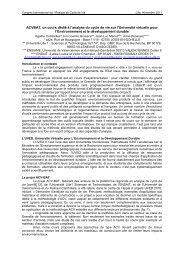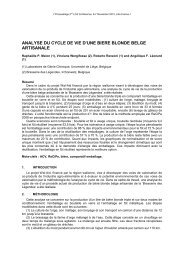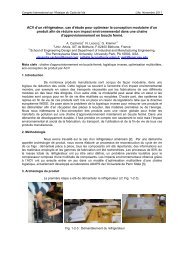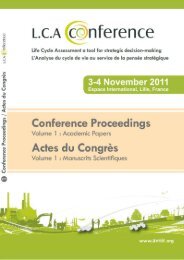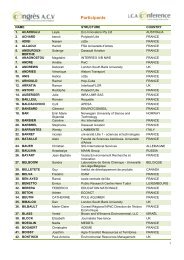Assessing Temporary Carbon Storage in Life Cycle Assessment and ...
Assessing Temporary Carbon Storage in Life Cycle Assessment and ...
Assessing Temporary Carbon Storage in Life Cycle Assessment and ...
You also want an ePaper? Increase the reach of your titles
YUMPU automatically turns print PDFs into web optimized ePapers that Google loves.
A fixed time horizon can be used (e.g. 100 years), which beg<strong>in</strong>s at the moment the first emission<br />
occurs, or a variable time horizon, which also beg<strong>in</strong>s at the moment when the first emission occurs, but<br />
f<strong>in</strong>ishes on a given year (e.g. 2100). With a fixed time horizon, the impact is assessed over the 100<br />
years follow<strong>in</strong>g the first emission. With a variable time horizon, the impact is assessed over a time<br />
horizon beg<strong>in</strong>n<strong>in</strong>g when the first emission occurs <strong>and</strong> f<strong>in</strong>ish<strong>in</strong>g <strong>in</strong> e.g. 2100. Policies are usually<br />
look<strong>in</strong>g at a given po<strong>in</strong>t <strong>in</strong> time on which some targets are fixed. The same can be done <strong>in</strong> LCA <strong>and</strong> a<br />
variable time horizon can be used. However, the problem with a variable time horizon is that it will<br />
change through time. Each decade, for example, it will probably be pushed back another 10 years, so<br />
that it will be constantly updated. PAS 2050 <strong>and</strong> the ILCD H<strong>and</strong>book 1 use a fixed time horizon as they<br />
are look<strong>in</strong>g at the radiative forc<strong>in</strong>g occurr<strong>in</strong>g 100 years follow<strong>in</strong>g the formation of the product. To be<br />
consistent, an assessment done next year should use the same characterization factors as an assessment<br />
done today, which means that it is better to use a fixed time horizon.<br />
3.6 Discount<strong>in</strong>g future emissions<br />
A dist<strong>in</strong>ction was made between the choice of a time horizon <strong>and</strong> discount<strong>in</strong>g, two different ways to<br />
express time preferences. Choos<strong>in</strong>g a time horizon consists <strong>in</strong> look<strong>in</strong>g at a particular environmental<br />
problem, which can be measured <strong>and</strong> documented, <strong>and</strong> then <strong>in</strong> mak<strong>in</strong>g decisions on the emergency of<br />
the situation or the relevance of future actions. Discount<strong>in</strong>g is based on the assumption that future<br />
impacts are less important because future generations will be better able to cope with the damage.<br />
There is science beh<strong>in</strong>d discount<strong>in</strong>g (economics, social science), but it is different from the “physical<br />
discount<strong>in</strong>g” on which time horizons are based. The general attitude <strong>in</strong> the LCIA community is to<br />
avoid discount<strong>in</strong>g <strong>and</strong> time cut-offs. The choice of time horizons or discount rates is value-laden, but<br />
cannot be excluded from this subject because it is impossible to give a value to temporary carbon<br />
storage without us<strong>in</strong>g time preferences.<br />
3.7 Treatment of biogenic carbon<br />
A general discussion followed on the treatment of biogenic carbon uptakes <strong>and</strong> emissions. The first<br />
comment was about the tim<strong>in</strong>g of the sequestration. If you have a forest, you cut a tree at time zero to<br />
make a wooden product, <strong>and</strong> then you plant another tree that will grow thereafter, the sequestration is<br />
not occurr<strong>in</strong>g at time zero, but is also delayed. This temporal issue should also be considered <strong>in</strong> the<br />
calculations.<br />
The other issue treated was whether credits should be given to temporary carbon storage only <strong>and</strong> only<br />
if a new s<strong>in</strong>k is created. Some argued that credits should not be given to transfer carbon from one non-<br />
1 This is the case provided that temporary carbon storage or delayed emissions are part of the goal of the LCA.<br />
15



